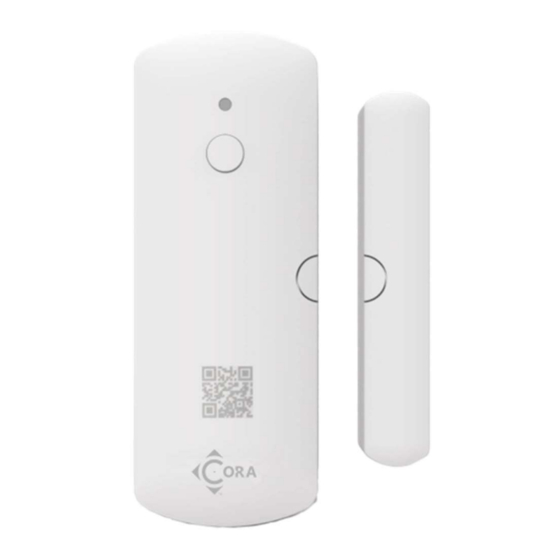
Table of Contents
Advertisement
Quick Links
Advertisement
Table of Contents

Summary of Contents for CORA CS1000
- Page 1 CS1000 Long Range Door Sensor User Guide Long-range, low-power door and window sensor supporting LoRaWAN or Coralink wireless protocols. Ideal for applications in smart-building, home automation, metering, and logistics. Version: 1.1 February 2022...
-
Page 2: Table Of Contents
CS1000 Long Range Door Sensor – User Guide Contents Getting Started ........................... 3 What’s In the Box ........................3 Attaching to the Network ......................4 User Interface ......................... 5 Reset / Status Button ......................5 Status Indicators ......................... 6 About LoRaWAN ........................6 Terminology .......................... -
Page 3: Getting Started
CS1000 Long Range Door Sensor – User Guide Getting Started The CS1000 is a long-range, low-power door and window sensor supporting LoRaWAN or Coralink wireless protocols. The sensor provides configurable real-time alarms or regular reported statistics. The sensor can be readily attached to doors, windows, or drawers and other equipment. The base unit detects the presence of a strong magnetic field (provided by the included magnet). -
Page 4: Attaching To The Network
12 hours. This is done to conserve battery power when the network is not available for long periods of time. You may reset the join schedule by performing a Network Reset on the device, see User Interface. To learn more about the capabilities of the CS1000, see Configuration and Integration. Page 4... -
Page 5: User Interface
User Interface Reset / Status Button The CS1000 user interface is comprised of the LED status indicators (Figure ) and the button shown below. Pressing the button quickly, will indicate the current network status discussed previously. Figure 3 – Performing Network or Factory Reset on the Door Sensor Holding the button will perform a network or factory reset: ... -
Page 6: Status Indicators
UDP (unconfirmed) protocols used for IP networks. Before a device, such as the CS1000 Door Sensor can transmit messages using LoRaWAN it must go through a “join” process. The Join process involves key-exchange with the cloud-hosted network provider (The Things Network, Helium, etc.) and is defined in the LoRaWAN protocol standard. -
Page 7: Installation
CS1000 Long Range Door Sensor – User Guide Installation The sensor and magnet are very difficult to relocate after being affixed to the mounting surface. Test the sensor and magnet location before affixing the device to the surface. Use masking or painter’s tape to secure the sensor and magnet to the surface (align the semi-circle on magnet with the semi-circle on sensor). - Page 8 CS1000 Long Range Door Sensor – User Guide Page 8...
-
Page 9: Alarms And Reports
CS1000 Long Range Door Sensor – User Guide Alarms and Reports The CS1000 Door Sensor has three standard alarm messages enabled by default: Door Open Alarm – Sensor changed from closed state to open state. Door Closed Alarm – Sensor changed from open state to closed state. -
Page 10: Reset Notifications
CS1000 Long Range Door Sensor – User Guide Statistics are stored in non-volatile memory and will persist through a battery change or dead battery. Both the statistic reporting and alarms can be configured remotely by sending downlink messages. The sensor has a periodic Heartbeat / Battery-status message that must be sent to maintain LoRaWAN network connectivity and provide battery status information. -
Page 11: Replacing The Batteries
CS1000 Long Range Door Sensor – User Guide Replacing the Batteries Remove the housing screw using a small Phillips screwdriver. Push the sensor body upwards and gently remove the sensor by pulling outwards. Remove old batteries and dispose of in accordance with your local regulations. - Page 12 CS1000 Long Range Door Sensor – User Guide Verify the sensor is functioning. The sensor will rejoin the network prior to communicating. Page 12...
-
Page 13: Configuration And Integration
CS1000 Long Range Door Sensor – User Guide Configuration and Integration Door Sensor supports the following settings and features, which are configured via downlink messages. Configuration Description Units Default Door Open Alarm Controls how often the Door Open minutes 0: disabled... -
Page 14: Specifications
CS1000 Long Range Door Sensor – User Guide Specifications LoRaWAN v1.03 Class A, Coralink™ Class A device U.S. 923 MHz, E.U. 868 MHz, China 470 MHz, and other frequencies available Color: White Sensor Magnetic Trigger Distance: 0.3 – 1.0 inches (8 – 25 mm) ... -
Page 15: Ordering Information
CS1000 Long Range Door Sensor – User Guide Ordering Information Communication Options Prior to ordering, determine the communication requirements: Application Protocol: Untethered XMF or CP-Flex OCM Network Protocol: LoRaWAN or Coralink Operating Region and Frequency: US915, EU868, CN470 (others available upon request) ... - Page 16 TTN sub-band 2. CS1000-UL-EU8ST-01 – Door sensor for Europe region, untethered, standard configuration, packaged for solution provider distribution. CS1000-CL-US9HT-00 – Door sensors configured for Cora OCM and CP-Flex cloud stack integration, Supports OCM V2 protocol specifications. Page 16...
-
Page 17: Fcc Statement
CS1000 Long Range Door Sensor – User Guide FCC Statement This equipment has been tested and found to comply with the limits for a Class B digital device, pursuant to part 15 of the FCC Rules. These limits are designed to provide reasonable protection against harmful interference in a residential installation.



Need help?
Do you have a question about the CS1000 and is the answer not in the manual?
Questions and answers